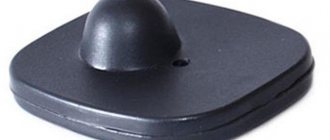It is relatively easy to get rid of dirt deposits in the body, but cleaning the engine compartment is much more difficult. In this case, cryoblasting or cleaning the engine compartment with dry ice is considered an ideal option. Specialists from cleaning companies that offer the service claim that the process makes it possible to eliminate imprints of dirt, carbon deposits, heavy grease stains, including contamination from fuel oil.
What is CRYO BLASTING?
This is a cleaning method that uses dry ice and its physical properties to instantly remove contaminants.
Dry ice, which has the hardness of chalk, cleans surfaces smoothly. The Cryoblasting process uses dry ice projection using compressed air blasters. This process is based on the simultaneous action of 3 physical phenomena... Kinetic energy Dry ice in the form of granules with a diameter of 3 mm is blown onto the treated surfaces at a very high speed thanks to compressed air and the use of supersonic nozzles (convergence / divergence). During impact, the granules generate a localized shock wave that promotes decohesion of contaminants on the treated surface.
Thermal differential
The temperature of the dry ice granules (-78.5 ° C) creates a thermal microshock between the contaminant and the surface and facilitates the removal of the latter. This is a temperature difference. The higher the temperature of the treated surface, the faster cryogenic cleaning occurs (for example, a gravity mold for an aluminum smelter).
Advantages and disadvantages of cryogenic blasting
Car dry cleaning has many advantages:
- There is no need to disassemble car parts. After processing, no additional drying or cooling is needed. Cleaning can be carried out even with the equipment running, without the risk of damaging the electronics.
- The time required to clean a car from dirt is about 3 hours.
- This method allows you to eliminate microorganisms invisible to the eye.
- Dry ice is not considered an abrasive substance and will not damage the coating.
- Cleaning with this method is highly effective, allowing particles to seep into the most difficult to reach areas.
Of the minuses:
- The gun nozzle cannot be directed into closed cavities.
- If the size of the granules and the air pressure do not match, there is a risk of damaging the car’s components.
When cleaning the engine, there is a small risk of damage to the paintwork. To prevent this from happening, it is necessary to select the size of the granules and the pressure under which they will be supplied.
How to clean with dry ice?
Dry ice blasting is an environmentally friendly and effective cleaning method. Unlike sandblasting and chemical cleaning, there is no residue and the cleaned item can be used immediately without pre-drying. Dry ice changes from solid to gas without the moisture or wetting of water ice. Therefore, it is also safe for cleaning electrical and other sensitive components.
BEFORE AND AFTER Toyota engine dry cleaning Before cleaning Before cleaning After BEFORE AND AFTER Toyota
ADVANTAGES:
What can be cleaned with frozen CO2
When sprayed, the layer of dirt cools and becomes brittle. Small pieces of ice heat up, pass into the smallest cracks and destroy the structure of mud deposits.
You can start cleaning the engine with dry ice after it has completely cooled down, since due to temperature fluctuations there is a risk of defects.
- Ice can be sprayed onto electrical elements, coils, spark plugs in cylinders - it does not damage the surfaces being cleaned.
- Cleaning the car interior is done by pouring granules whose diameter is no more than 0.03 mm. When cleaning the interior, its elements are not damaged, since the ice instantly evaporates. Under pressure, dirt is effectively cleaned from various hard-to-reach areas.
Cleaning the engine compartment of a car, depending on the size of the engine and the level of contamination, will require from 7 to 15 kg of ice. All separated dirt falls under the car and does not cause problems in cleaning.
Dirt in the engine compartment prevents problems from being recognized in a timely manner, it looks unsightly, and the presence of oil stains sometimes leads to a fire. Therefore, it is necessary to periodically clean the engine compartment.
Cryogenic cleaning is a procedure that uses innovative, high-tech equipment. Therefore, it is available only in specialized services.
Useful tips
As for the volume of loaded ice, small units can hold up to 30 kg of the substance, but larger blasters, which are usually used in industry, can hold up to two hundredweight of ice. Of course, its mobility depends on the size and weight of the installation. The smaller the blasters, the easier they are to transport, but bulky units are much more difficult to move.
The pressure at which the ice is supplied can also vary, for example:
- if you need to remove only small dirt, then a pressure of about 8 bar will be enough;
- if it is necessary to deal with complex pollution, this figure must be approximately doubled.
Along with their main products, blaster manufacturers also sell additional accessories - various attachments and guns that improve the supply of ice granules.
Many of them allow the substance to penetrate into the most inaccessible places. Dry ice cleaning of cars is an ideal solution if you need to clean the engine or interior of your car. This unique technology helps deal with various types of contaminants.
Blasting Features
Cryogenic blasting is a high pressure washer, but instead of regular water it uses ice pellets. Having a very low temperature, carbon dioxide, falling on the surface of engine parts, freezes the contaminants present on it, as a result of which the latter become more fragile and therefore are easily separated.
Cryogenic blasting is absolutely safe for car engine parts. After the cleaning procedure, there is not the slightest damage left on them, since carbon dioxide is not an abrasive substance.
Thanks to dry ice, you can eliminate various, even the most stubborn, stains.
Pros and cons of the method
Cleaning the engine with dry ice was first used in the West at the beginning of the 21st century. Since then, this technique has spread widely everywhere due to its undeniable advantages:
- High penetrating ability. The surfaces of complex technical objects can be effectively cleaned without prior disassembly. When using a variety of attachments, tiny particles can reach many places that are inaccessible to other manual cleaning methods.
- Maximum environmental friendliness of processing. No harmful liquid waste is generated that requires disposal.
- The method is universally applicable and effective for a large number of materials to be cleaned: metals, plastics, wires, fabric surfaces, upholstery.
- Safety for processed products. Dry washing does not create moisture and is unable to damage electrical wiring and appliances. The risk of short circuit is completely eliminated.
- The cleaning process does not involve abrasive elements. Ice granules are unable to damage or scratch the paintwork.
- The processing time for the engine compartment is approximately half that of traditional engine washing methods, since disassembly before the procedure and final drying after it are not required.
While there are obvious advantages to cleaning the engine with ice, there are also disadvantages. Their number is much smaller:
- relatively high cost;
- insufficient prevalence of service delivery points.
Technology and equipment
There are several types of installations for work - for wet or dry reagent. In the first, a high-concentration reagent is mixed with water and then supplied under pressure to a sprayer. The second installation produces a stream of air in which abrasive particles are dissolved. The most commonly used devices are: Torbo, OptiBlast, SBS.
A nozzle is directed to the problem area and air with a reagent flows through it. Once the jet of dissolved dry ice reaches the surface, it cools. Contact with carbon dioxide causes multiple micro-explosions, due to which particles of paint and dirt come off the surface. The ice itself evaporates instantly, leaving no traces. When removing paint from walls, a pressure of 6 bar is sufficient. To treat difficult areas, the pressure increases to 12-16 bar.
For work in open spaces, installations that do not require a network connection are used. They operate using the power of compressed air. This is used over large areas. For large volumes, it is better to purchase a system that includes a granulator and a dry ice generator. The container of an ice unit used in a service station usually has a capacity of 10-30 kg, and an industrial one - up to 200 kg.
According to the instructions, a worker involved in cryogenic blasting needs a protective suit, gloves and goggles. This is enough for protection.
When cleaning the surface, you can use 3 modes at once - cleaning, degreasing and removing moisture. This technology minimizes processing and speeds up the process.
The Germans will begin cleaning aircraft engines with dry ice
Lufthansa Technik Group / YouTube
German aircraft repair and maintenance company Lufthansa Technik has announced the successful development and testing of a new aircraft engine cleaning system. According to the company, the new technology involves using dry ice to clean power plants, rather than water, as in traditional methods.
Today, for washing aircraft engines, special installations are used that supply water under pressure into the engine. Special detergents are mixed into the water to remove dirt. You can use water to wash the engine at an air temperature of at least 5 degrees Celsius, otherwise ice may freeze in the power plant.
The new installation, called Cyclean 2.0, instead of water, sprays grains of dry ice several millimeters in diameter into the engine. These particles, with a temperature of about -78 degrees Celsius, hitting the internal elements of the engine, knock off dirt from them, which is then blown out of the power plant.
Cleaning aircraft engines with dry ice takes about 30 minutes versus just over an hour with water. However, dry ice cleaning can also be used at sub-zero temperatures. After cleaning, the remaining dry ice particles simply turn into a gaseous state.
Lufthasna Technik intends to conduct additional tests of the new technology in the near future. The German company intends to start using the new Cyclean 2.0 installation during routine maintenance in 2022. At the same time, there are no plans to completely abandon the water method of cleaning engines.
In 2015, the American company Spirit AeroSystems began using a new method of repairing aircraft parts without exposure to temperature or the need to completely dismantle them and place them in an autoclave. We are talking about cold gas dynamic spray technology, which has already received approval from the US Federal Aviation Administration.
Cold gas dynamic spraying technology involves applying metal dust to a damaged surface. A supersonic gas flow, usually nitrogen or helium, accelerates powder particles with a diameter of one to 50 micrometers to speeds of 500-1000 meters per second. When hitting a hard surface, these particles are deformed, firmly adhering to it.
The particle atomizer is controlled by a computer. The technology allows you to restore the surface of a damaged part, removing, for example, microcracks. In general, this method allows several times to reduce the time required to repair certain damaged parts, including those made of composite materials.
Vasily Sychev
How is it carried out?
The car is driven onto a special platform in advance. You should wait half an hour until the engine has completely cooled down. A ground wire is connected to the car body. Next, crystal dry ice, cooled to a temperature of -80 degrees Celsius, is thrown into the sandblasting device. To clean the engine compartment, the volume of granules varies up to 1.5 millimeters. The device is connected to a compressor.
Before starting the procedure, you must allow the machine to cool completely.
The wings, shock absorber, bumper and other tuning components are covered with a rubber awning. Engine processing elements must be cold. Then the dispatcher sprays dry ice under pressure throughout the engine compartment with extremely careful and even movements up and down. All cracks, gaps, corners and large areas are cleaned by pointing the gun at a directly even angle to the surface. When cold ice granules come into contact with the engine, they instantly acquire the state of gas and take with them contaminants, including grease stains.
Due to cryogenic blasting of the engine compartment, the resulting surface is spotlessly clean and completely dry.











